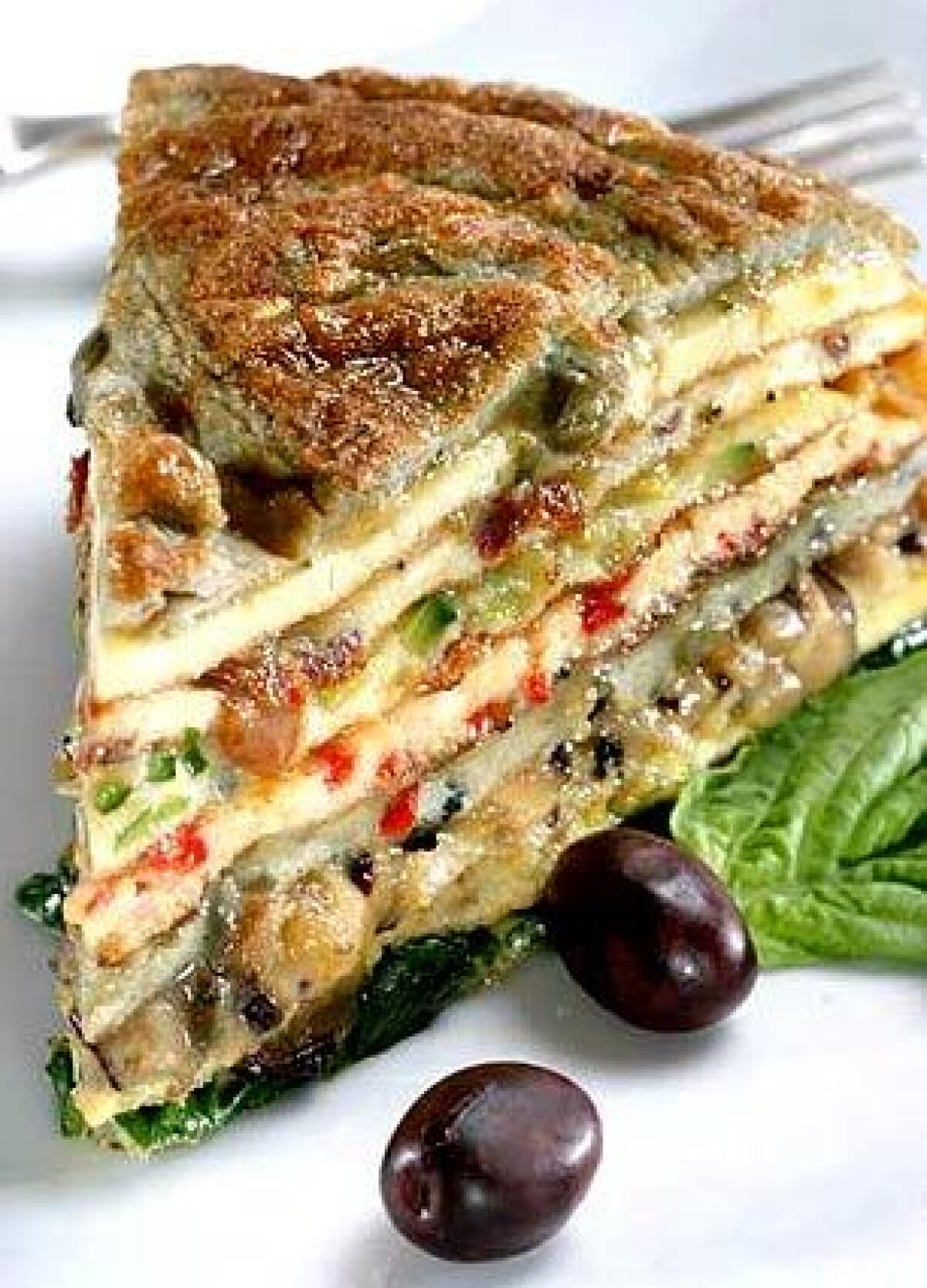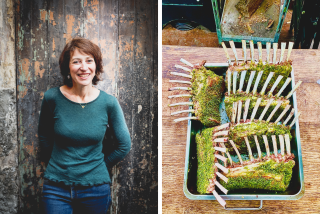Crespéou, an edible ticket to Provence

- Share via
IT can’t be an accident that this summer’s hit movie features a dish from Provence. No other region of the world has so many potential sequels so suited to the season — after ratatouille, they could start with aioli or bouillabaisse and keep going through pistou and salade niçoise.
And those are just the familiar signatures from a part of France where the cuisine is almost literally sunny. Far more obscure dishes could be art house sensations too — which makes crespéou the “Big Night” of Provençal cooking.
I first encountered it in a countryside restaurant in the Luberon 10 years ago when I ordered an appetizer with no idea what it might be and was rewarded with a gorgeous wedge of what was essentially a round terrine made from thin, open-face omelets, half of them yellow from eggs alone, the rest colored red from the addition of roasted peppers. It was served at room temperature, so the flavors were very direct, and it was sensational.
Two years ago I found an even more dramatic crespéou on the buffet table at a friend’s party near the pool at her summer home outside the village of Eygalières: At least 20 thin omelets of varying colors and with contrasting ingredients were stacked on a platter wreathed with lavender sprigs to make a towering cake to be sliced to order. The cascade of local flavors was dazzling: anchovies, basil, olives, eggplant, zucchini, capers, mushrooms, peppers, tomatoes and more.
Crespéou (pronounced cress-PAY-oo) is sometimes called gateau d’omelettes, which is a bit like underselling ratatouille as vegetable stew. It is an omelet cake, but it can be an hors d’oeuvre or a main course, party food or solitary supper, hot main dish or cold snack. And it is the greatest idea since the frittata for using anything you have on hand in summertime. (Calling it clean-out-the-refrigerator fare is not very glamorous, but it applies.)
--
Vintage variations
LIKE ratatouille, crespéou can be made myriad ways. The easiest is just to cook up a stack of open-face omelets, piling them on a plate as they firm up and brown slightly, then cut the assemblage into wedges to serve right away. But it is much more common to stack the omelets and then weight them overnight so that they compress and cling together even more. The contrast among flavors in every layer is more pronounced.A recipe I tore out of a French food magazine I bought on my first trip to Provence 10 years ago called for even more drama: This crespéou was layered into a springform pan, then covered in an egg-and-cream custard and baked to make something like a cross between a quiche and a crespéou. The extra step strikes me as overkill, though.
Another variation turned up in Simone Beck’s “New Menus From Simca’s Cuisine,” a classic cookbook from 1978 a friend loaned me after hearing I was trying to re-create a dish even a French friend did not know well. The late cookbook author, who collaborated with Julia Child on her first master work, called her take “les omelettes en sandwich,” and she properly touted it as a great destination for the bits and pieces and ends of jars in the refrigerator: “leftover vegetables, stray bits of cheese, a teacup with the last bit of tomato sauce.” Six omelets are stacked and served immediately in this version.
Interestingly, Beck noted that the same dish could be made with crepes in wintertime as a way of cutting back on the eggs, which in a seasonally sensitive world were scarcer and thus more expensive while chickens were molting. Our all-food-all-the-time attitude precludes that, but crepes could be cool in a summer crespéou too.
What makes crespéou appealing for an American cook is that it is so free-form. You can flavor the different layers with just about anything, and you can build it as high as you like. Starting with Provençal standards makes sense, and it is hard to surpass alternating layers of eggs spiked with tapenade, anchovies, basil, zucchini, garlic, spinach, capers, eggplant, tomatoes and more.
Crespéou is much more forgiving than a one-on-a-plate omelet breakfast. If any layer is less than perfect, you can be sure no one will notice any imperfection; the layers all meld in a way stand-alone eggs never do.
Cooking all the open-face omelets is also very easy: You just need to beat the eggs well with salt and pepper and mix in any seasonings, then heat a teaspoon or so of olive oil in a 9-inch sauté pan and scramble the eggs until they hold together in a single flat layer. If you want them to be very thin, don’t stir them as they set; otherwise, whisk away.
And while the recipe that follows is relatively precise, you can feel free to adjust the timing and make the eggs more golden on the bottom rather than crustier-brown, or keep the top side moist to the point of wet.
No matter how you proceed, rosé is the perfect accompaniment for crespéou. And while you generally need no sauce or garnish with it, you can serve it with a green or potato salad or add a tomato coulis or a sauce of puréed roasted red peppers. Or just arrange some gleaming niçoise olives alongside and maybe some tomato slices with basil.
Crespéou costs more to make than mere omelets, but even at the price of two movie tickets, it is the easiest way to be transported to Provence.
--
food@latimes.com
--Crespéou
Total time: About 1 1/2 hours
Servings: 6 to 8
Note: To make this ahead for a more dramatic presentation as an appetizer for a party, stack the omelets and weight them for at least 8 hours, refrigerated, to compress the layers. Slice into thin wedges or anchor with toothpicks and cut into bite-size squares like a Spanish tortilla.
1/2 pound fresh spinach, stems removed
About 4 tablespoons best-quality olive oil, divided
1 small zucchini, diced
1 clove garlic, minced
Coarse sea salt to taste
Freshly ground black pepper to taste
6 shiitake mushrooms, stemmed, caps wiped clean and thinly sliced
18 large eggs
2 anchovy fillets, drained and coarsely chopped
1 tablespoon tapenade
4 piquillo peppers, drained, dried and diced
2 tablespoons capers, drained
3 oil-packed sun-dried tomatoes, drained and finely chopped
1 tablespoon pesto
1. Fill a medium saucepan with water and bring it to a boil over high heat. Wash the spinach well in several changes of water and drain. Place the leaves in the saucepan, cover and cook over high heat until wilted, 15 to 20 seconds. Drain well, squeeze dry and coarsely chop. Press the spinach between paper towels to drain any additional moisture. Set aside.
2. Heat 2 teaspoons olive oil in a heavy-bottomed 9-inch sauté pan over medium heat. Add the zucchini and garlic, and season with salt and pepper to taste. Cook, stirring constantly, until soft and starting to brown. Transfer to a small bowl.
3. Heat 2 1/2 teaspoons oil in the pan over medium heat. Add the shiitakes and season with salt and pepper to taste. Cook until soft, then transfer to a small bowl. Wipe the pan clean.
4. Beat 2 eggs in a medium bowl with salt and pepper to taste. Add the cooked spinach and mix well. Heat 1 teaspoon olive oil in the sauté pan over medium heat. When it shimmers, add the egg mixture and cook, stirring and lifting to make a puffy, open-faced omelet; the eggs should be set but still moist on the top. Slide onto a 10-inch serving plate, moist side up.
5. Beat 2 more eggs in a bowl and season with pepper only, then stir in the anchovies. Heat 1 teaspoon oil in the pan, cook the egg mixture like the spinach omelet and lay onto the spinach omelet.
6. Repeat with 2 more eggs and the shiitakes. This layer will not need additional seasoning.
7. Repeat with 2 more eggs, pepper only and the tapenade.
8. Repeat with 2 more eggs, salt and pepper and the piquillos.
9. Repeat with 2 more eggs and the zucchini. This layer will not need additional seasoning.
10. Repeat with 2 more eggs and the capers.
11. Repeat with 2 more eggs, salt and pepper and the sun-dried tomatoes.
12. Repeat with 2 more eggs, pepper only and the pesto, but carefully flip and slide this omelet onto the stack moist side down.
13. If serving immediately, cut the crespéou into wedges. Otherwise, weigh down several hours before slicing.
Each of 8 servings: 274 calories; 17 grams protein; 6 grams carbohydrates; 1 gram fiber; 20 grams fat; 5 grams saturated fat; 477 mg. cholesterol; 310 mg. sodium.
More to Read
Eat your way across L.A.
Get our weekly Tasting Notes newsletter for reviews, news and more.
You may occasionally receive promotional content from the Los Angeles Times.









